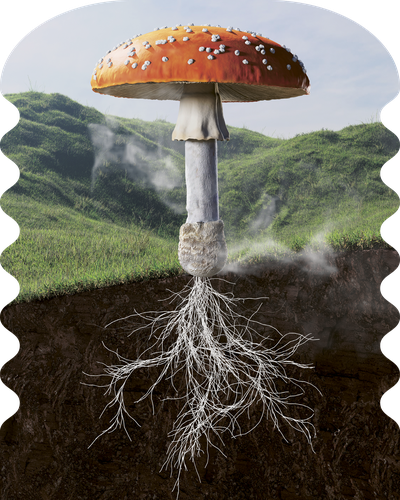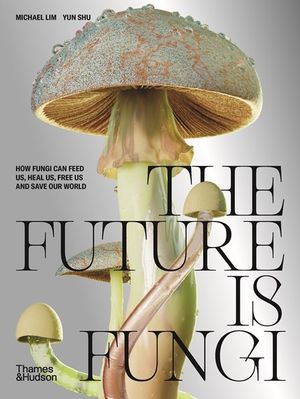The Future Is Fungi explores the mighty mycelial reach of fungi across four key areas: food, medicine, psychedelics and the environment. With mushroom profiles, informative texts on foraging and glorious 3D art, it’s a fascinating introduction to this hidden kingdom.
Nothing alive exists in isolation. To be alive means to be part of an intricate, sprawling web of cause and effect. Our lives are interwoven with that of plants, animals, bacteria and fungi, forming the beating heart of the planet we are in partnership with.
The most underappreciated and under-researched of these threads of life is the kingdom of fungi. Fungi are incredibly powerful and complex and their omnipresent role in nature is still widely unrecognised. As light shines on this mysterious world, we believe that future research and investment into this space will only grow. Rapidly.
Fungi shape and transform environments, underpinning the wellbeing of nearly all terrestrial ecosystems. Despite spending most of their lives hidden underground or inside plants and animals, fungi are responsible for critical ecosystem processes. Some weave through the earth, decomposing matter and recycling nutrients to build healthy soils for plants and animals to flourish in. They are the interface between death and life – without them, the world would be buried under fallen trees, the remains of animals and infertile soil. Others form intimate and intelligent partnerships with all forms of life, supporting the health of most – if not all – organisms. Modern-day privileges such as beer, wine, chocolate, bread, penicillin and detergent depend on fungi for their production, and a potent group also contains psychoactive compounds that can initiate transformative experiences of love, creativity and connection.
It is safe to say that without fungi, the world as we know it would not exist. Fungi are nature’s alchemists and hold untold answers for our future on Earth.

Where did we all come from?
To best appreciate the importance of fungi, let’s start at the intersection of science and history.
Our Earth is 4.5 billion years old. The tree of life can be traced back to LUCA – the Last Universal Common Ancestor – some 4 billion years ago. The earliest living organisms were basic, single-celled prokaryotes. Single-celled organisms are the smallest thing you can be and still be considered a living organism. They are represented by the domains Archaea and Bacteria. Trees, birds, insects and fish, as we know them today, did not exist.
Over millions of years, to survive the changes in Earth’s conditions, prokaryotesfused into larger and more complex living organisms called eukaryotes, enabling the diversity of nature that we see today. Eukaryotes form the domain Eukaryota, which is organised into four kingdoms: Plantae (plants), Animalia (animals), Fungi and Protista (everything else). Humans are mammals, and sit within the kingdom of Animalia, along with all other animals from electric eels to elephants. It is humbling to contemplate that all life, be it an oak tree or Gandhi, descended from the same primitive organisms.
Fungi diverged from animals 1 billion years ago. So close are the Fungi and Animalia kingdoms that taxonomists speak of a super-kingdom that combines the two: Opisthokonta. This billion-year-old divergence was only recognised in 1969 when ecologist Robert Harding Whittaker formalised their importance, scale and diversity with the new kingdom classification. Previously, fungi were classified as plants, and dismissed as lower-class organisms, tucked away in an obscure corner of the botany department.
As Whittaker recognised, fungi are more closely related to animals than plants. Say hello to your evolutionary cousin – we share almost 50 per cent of our DNA with fungi.
The basic building blocks of fungal cell walls are chitin, the same material as the hard shells of crustaceans and insects. The cell walls of plants, in contrast, are built from cellulose. Like animals, and unlike plants, fungi are heterotrophs – they are unable to produce their own food and must instead obtain food from their environment. Animals opted to internalise their stomachs, while fungi pursued external ones. They secrete enzymes into the environment to digest food externally before absorbing it into their cells. Fungi also have a remarkably wider taste palette than we do, consuming everything from stale bread to plastics and even nuclear waste. This ability is the basis for modern food and medicine biotechnology, and has applications in environmental remediation.
Fungi are inherently difficult to study in nature, as the majority of species are microscopic or underground, but mycologists have made great strides in recent decades. Technological advances make it possible to identify fungal DNA in the environment. Unfortunately, the DNA doesn’t match any records because a comprehensive catalogue of fungal DNA does not yet exist. Even once catalogued, the species could sit in a fungarium for decades before funding is granted to understand their role in nature, their interactions and how they fit into the tree of life.
To date, only 120,000 species of fungi have been identified. Using a complex process called DNA barcoding, scientists estimate that over 6 million fungal species exist innature, which means that 98 per cent are still to be discovered, highlighting the untapped potential of mycology. Every year, a few thousand new species are described. At this rate, it will take more than a thousand years to identify all the fungi on Earth. Mycologists obviously aren’t running out of new species to discover – the limiting factor is simply that there aren’t enough mycologists. The practice of cultivating mushrooms,or mycoculture, also has an engaged citizen scientist community that pushes the field forward. Websites such as iNaturalist and Mushroom Observer allow amateur mycologists and enthusiasts to log the mushrooms that they find to generate data on fungi diversity and conservation.
We know substantially less about fungi than we do about animals and plants, but discoveries are underway. In fact, fungi rarely leave the news cycle. Fungi are a key player in the biotechnology revolution, plant-based food movement, health supplements industry, grassroots remediation and psychedelic renaissance.



